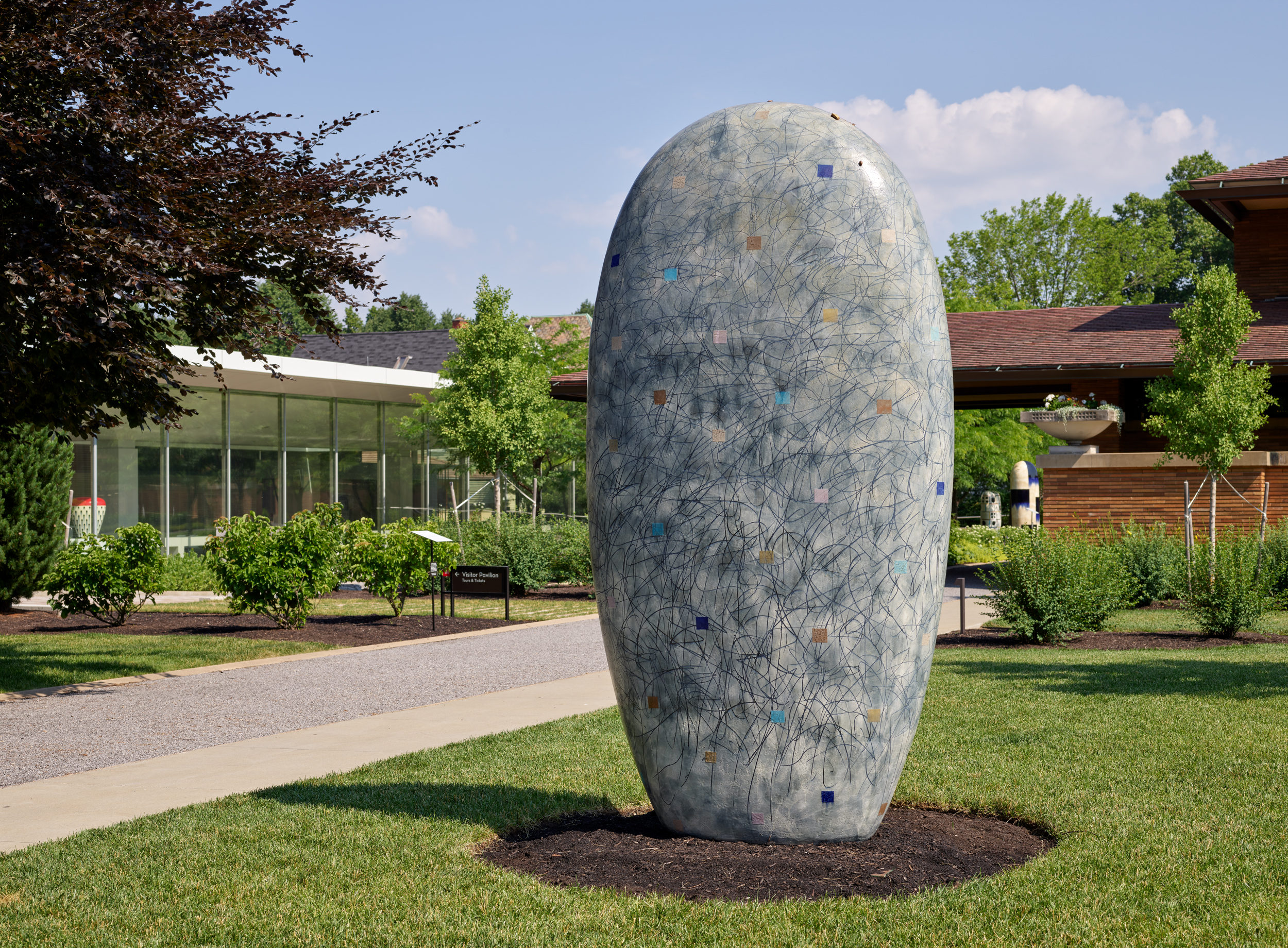The Martin House is pleased to partner with the Albright-Knox Art Gallery’s Public Art Initiative to present an exciting installation featuring artist Jun Kaneko’s monumental ceramic sculptures. The installation comprises seven of the artist’s enormous, freestanding ceramic works for outdoor display on the newly-restored grounds of the Martin House estate, as well as a series of smaller works on view indoors.
Born in Japan in 1942, Kaneko is an internationally renowned artist primarily known for his pioneering work in ceramic materials. His large pieces, called dangos, are the result of a complex traditional Japanese raku firing and glazing process that produces unique geometric shapes and vibrant color combinations.
“We are proud to partner with the Albright-Knox, and it is a joy to collaboratively present this playful artwork that will engage and inspire visitors of all ages,” said Mary Roberts, Martin House Executive Director. “Much like Frank Lloyd Wright, Kaneko is a pioneer in his field of artistic design, pushing the boundaries of materials and their use.”
The installation is a unique opportunity to experience the interaction of Kaneko’s sculptures, Wright’s architecture, and the surrounding landscape. Wright also had an enduring interest in Japanese arts and culture and a reverence for nature, all of which are beautifully captured in Kaneko’s work.
“The pieces enhance the visual landscape of the estate with their artistic presence and organic nature, making the Martin House landscape the perfect place for meditation and reflection while promoting civic interaction,” said Roberts.
Many of Kaneko’s works represent years of production time due to their immense scale, which takes months to slowly build up to avoid being crushed under their own weight. The tallest works in the exhibition are more than 10 feet tall with walls in excess of three inches thick and weigh close to 3,000 pounds. Their fired slip-surfaces create a glasslike coating suitable for outdoor public display in the extreme weather conditions that will occur during the 17-month installation.
In addition to the seven large works on the grounds, several smaller works are on view inside the Eleanor and Wilson Greatbatch Pavilion, the Martin House public visitor center. Download a map with sculpture dimensions and locations on the estate.
The selection of works for the installation has been curated by Albright-Knox Public Art Curator Aaron Ott and organized by Martin House Curator Susana Tejada.
“We are thrilled to be collaborating with the Martin House to present this striking public art installation,” said Aaron Ott. “Kaneko’s artworks dovetail beautifully with the incredible work of Frank Lloyd Wright, providing visitors with a unique experience that blends world-class art and architecture.”
This is not the first installation of Kaneko pieces at a Frank Lloyd Wright residence. Enjoy these photos from a Kaneko installation at the David and Gladys Wright House in Phoenix in 2018.
About Jun Kaneko
Kaneko, born in Nagoya, Japan, in 1942, is considered one of the world’s preeminent ceramic artists working today. Through the late 1950s and early 1960s, Kaneko studied painting in Japan under Satoshi Ogawa. With Ogawa’s counsel, Kaneko, who had never been to the United States and spoke no English, arrived for the first time in August 1963 at age 21.
Kaneko became connected to Los Angeles–based collectors and patrons who invited him to stay at their home and helped acquaint him with American culture. Coincidently, they were enthusiasts of contemporary ceramics, so Kaneko spent three weeks among extraordinary works by avant-garde California ceramic artists who inspired him to take up the medium of clay in his own work.
A 1982 part-time residency at the Alternative Worksite (now the Bemis Center for Contemporary Arts) in Omaha, Nebraska, and the concurrent opportunity to use one of the enormous beehive kilns at the Omaha Brickworks, provided Kaneko the means to experiment with a radical jump in scale. The chance to pursue even more ambitiously scaled works arose ten years later when he was granted access to the out-of-service beehive kilns at Mission Clay Products in Fremont, California. Accompanied by three assistants, Kaneko brought the necessary equipment from Omaha and proceeded to mix a ton of clay every other day for nearly three months. From these opportunities and experiments, the signature forms of his monumental dangos emerged.









